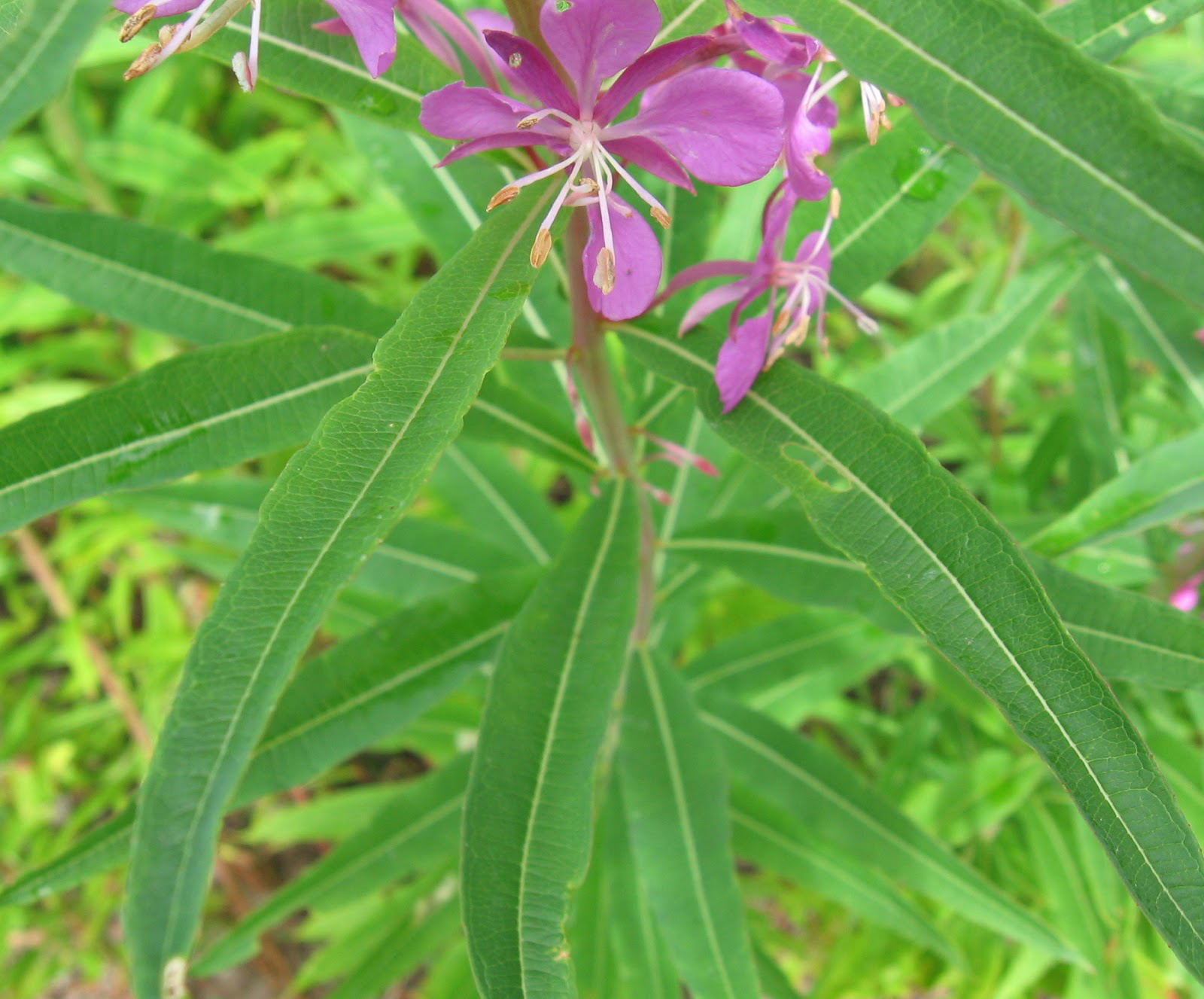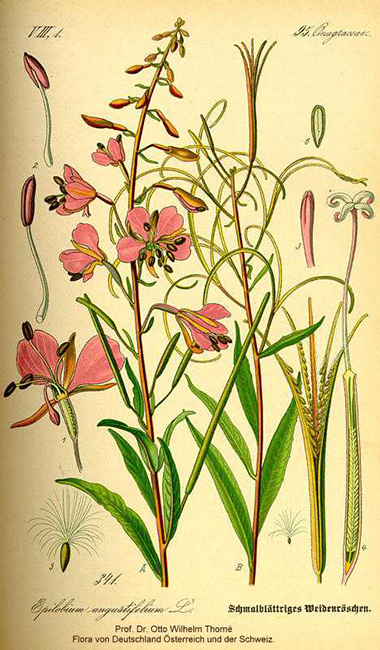Fireweed has also been referred to as Fireweed, Great Willowherb, Rosebay Willowherb, Spiked Willowherb, Narrow-leaved fireweed, Perennial fireweed, Great willow-herb, Flowering willow, Rosebay willow-herb, Blood Vine, Blooming Sally, Fireweed, Flowering Willow, Willow Herb and Purple Rocket.
Plant
Fireweed is a perennial herbaceous plant, 2-9 ft. (0.6-2.7 m) tall which is found growing in semi-shaded forested areas and in sunny meadows and tends to grow in all types of soil but normally it prefers well-drained soils. It has wide spreading horizontal roots extend down vertically to 17.7 inches (45 cm) from the plant, with most growing between 0 and 5.9 inches (0-15 cm) deep whereas purplish-red stems that are simple, erect, smooth, 0.5–2.5 m (1½–8 feet) high.
Normally leaves are alternate, arching to ascending, lanceolate, pointed, hairless, becoming smaller at top of stem, 3-8 in (7.5-20 cm) long, to 0.75 in (2 cm) wide; little or no stalk and are dark green above and silvery below. Flowers are rose to purple, rarely white, with 4 petals 8-20 mm long. Numerous flowers in terminal greatly elongate clusters, lower flowers blooming first. Sepals are 8-12 mm long with style 1-2 cm long, longer than the 8 stamens, softly long- hairy on the lower portion, stigma 4-cleft. Flowering normally starts from June to September. Fruits are long, very narrow pod, gray-hairy, 2-3 in (5-7.5 cm) long, and held upright; peeling open length-wise to release thousands of small hairy-tufted seeds. Numerous minute brown seeds are present with a tuft of silky, white hairs at the tip.
History
Fireweed is a perennial herbaceous plant in the Asteraceae that is native to Australia and New Zealand and has been naturalized in northern USA (in the states of Washington, Oregon and California). It is considered a problem invader in the Channel Islands, California, and USA. It is able to rapidly colonize and dominate disturbed areas such as those cleared by logging activity or fire. Along with other nonnatives, it is possibly threatening native species in California. Nowadays it is found growing throughout the world because of its high nutrient content and wonderful use in the food item.
Nutritional Value
The serving size of one cup of 23 grams provides 24 calories. It provides nutrients, minerals and vitamins in various amounts. The same amount offers 1.542 mg of Manganese, 0.145 mg of Vitamin B6, 99 mg of Calcium, 36 mg of Magnesium, 0.074 mg of Copper, 0.55 mg of Iron, 1.075 mg of Vitamin B3, 26 µg of Folate and others.
Health Benefits of Fireweed
The flowers attract bees and hummingbirds due to its ragged appearance. Fireweed provides food to some animals as well as healing properties to the humans. Fireweed is used to treat swelling, inflammation, wounds, tumors, fevers and enlarged prostate. Some of the health benefits are described below:
- Bone health
Manganese helps in the growth of bone structure. It aids the increase of mineral density in spinal bones in post-menopausal women. After menopause, women suffer from deficiency of manganese so the minerals consumption should be increased to prevent the fractures. The manganese has the ability to prevent osteoporosis and slows down the growth of debilitating disease. (1)
- Prevent diabetes
Manganese helps to control the sugar level in the human blood which also prevents from the diabetes. Manganese normalizes the secretion and synthesis of insulin as well as regulating unpredictable drops in the blood sugar which provides normal life for the diabetic patients. (2)
- Regulates metabolism
Manganese helps to regulate the metabolism of body. It activates the enzymes which assist metabolizing amino acids, carbohydrates and cholesterol. It is vital for metabolism of Vitamin B1 and Vitamin E. In addition, it assists in the proper function of liver. It is vital part of glutamine and DNA polymerase. (3)
- Prevent PMS
Manganese helps to eliminate the headaches, mood swings, irritability and depression caused by premenstrual syndrome. The study shows that manganese helps to treat PMS symptoms. As the manganese has the impact on the function of hormones so it is better to take a suggestion from doctor. (4)
- Thyroid ailments
Manganese is a vital component of thyroxine which is an essential hormone for thyroid glands. The effective function of thyroid gland and the hormonal synthesis helps in weight loss, metabolism, appetite and efficiency of organs system. (5)
- Assist blood vessels
Vitamin B6 helps to regulate the homocysteine levels in the blood which could be obtained from the meat or protein sources. The high presence of homocysteine in the blood leads to inflammation, blood vessel disease and heart disease that may lead to heart attack.
The homocysteine level builds up in the absence of Vitamin B6 which could damage the lining of blood vessels. It leads in harmful buildup of plaque that results to stroke or heart attack. The study shows that the intake of Vitamin B6 with folate helps to reduce homocysteine levels and also heals the damage. Vitamin B6 helps to manage the cholesterol and blood pressure level which are the main causes for heart disease.
- Brain function
Vitamin B6 assists in the development and functioning of brain. The deficiency of Vitamin B6 affects the memory, cognitive impairment, dementia and Alzheimer’s disease. Vitamin B6 is required for making the hormones such as norepinephrine and serotonin which controls the concentration, energy and mood. The research shows that Vitamin B6 may be useful for the children with ADHD and improve their learning as well as behavior.
- Enhance mood
The research shows that Vitamin B6 has an impact on the production of GABA neurotransmitters and serotonin in the brain. These hormones help to control the mood and prevent pain, depression, anxiety and fatigue. It helps to prevent the mood disorders. Vitamin B6 helps to treat the brain diseases and uplifts the mood, avoid lack of energy, concentration and experience less pain.
- Improves vision
The deficiency of nutrient and poor diet are the main causes of eye diseases. The study shows that Vitamin B6 with other vitamins such as folate helps to prevent the vision loss and eye disorders. Vitamin B6 helps to slow down the growth of macular degeneration which is the age related disease.
- Cures anemia
Vitamin B6 is essential for the creation of hemoglobin in the blood which is passed by red blood cells in the body in order to transport the oxygen to the cells and utilize iron. Anemia is caused due to the low presence of red blood cells and results the symptoms such as aches, fatigue and pains. The study shows that the consumption of Vitamin B6 reduces the symptoms of anemia and also prevents it from occurring.
Other Facts
- A fiber obtained from the outer stems can be used to make cordage.
- The ‘cottony’ seed hairs has been used as a stuffing material or as tinder.
Comments
| Fireweed Quick Facts | |
|---|---|
| Name: | Fireweed |
| Scientific Name: | Epilobium angustifolium |
| Origin | Temperate Northern Hemisphere |
| Shapes | Capsule, tubular, thick hair, Length: 5–8 cm (2–3.2 inch) (Fruit) |
| Calories | 24 Kcal./cup |
| Major nutrients | Manganese (67.04%) Vitamin B6 (11.15%) Calcium (9.90%) Magnesium (8.57%) Copper (8.22%) |
| Health benefits | Bone health, Prevent diabetes, Regulates metabolism, Prevent PMS, Thyroid ailments |
| More facts about Fireweed | |
| Rank | Scientific Name & (Common Name) |
|---|---|
| Kingdom | Plantae (Plants) |
| Subkingdom | Tracheobionta (Vascular plants) |
| Superdivision | Spermatophyta (Seed plants) |
| Division | Magnoliophyta (Flowering plants) |
| Class | Magnoliopsida (Dicotyledons) |
| Subclass | Rosidae |
| Order | Myrtales |
| Family | Onagraceae (Evening Primrose family) |
| Genus | Chamerion Raf. ex Holub (Fireweed) |
| Species | Chamerion angustifolium (L.) Holub (Fireweed) |
| Synonyms |
|









